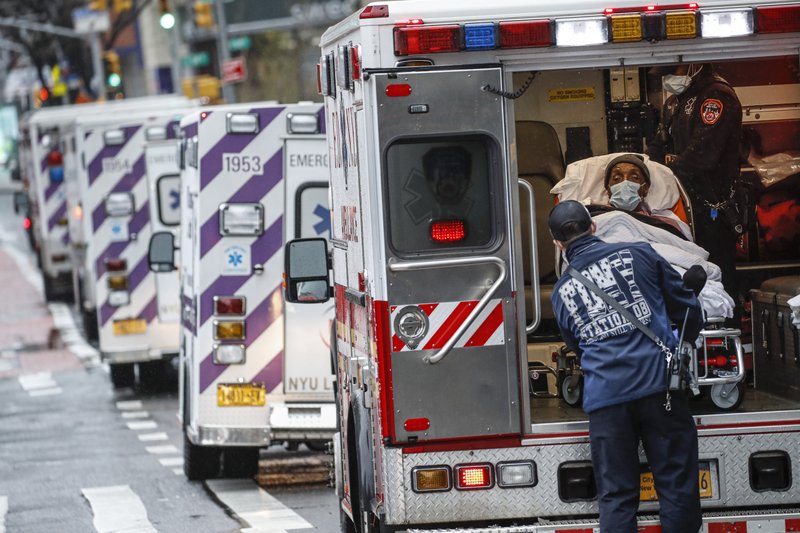New York state reported more than 1,700 previously undisclosed deaths at nursing homes and adult care facilities as officials faced scrutiny over how they have protected vulnerable residents from the coronavirus.
At least 4,813 people have died from COVID-19 in the state’s nursing homes since March 1, according to a tally released late Monday that, for the first time, included people believed to have been killed by the virus before their diagnoses could be confirmed by a lab test.
Exactly how many nursing home residents have died remains uncertain despite the state’s latest disclosure. The list released by Gov. Andrew Cuomo’s administration did not include nursing home residents who were transferred to hospitals before dying.
With the inclusion of the additional deaths, the state now lists 22 nursing homes as having at least 40 deaths. Most of the facilities are in New York City and on Long Island. Sixty-two nursing homes reported between 20 and 39 deaths.
Parker Jewish Institute in Queens and the Isabella Geriatric Center in Manhattan are listed as having the most deaths: 71 and 64, respectively. Even those numbers are likely an undercount. Isabella Geriatric Center officials have said publicly that 98 residents are believed to have died, including those sent to hospitals.
Audrey Waters, a spokeswoman for Isabella Geriatric Center, said in an email last week, that the home, like others in the city, initially had limited access to tests to quickly diagnose residents and staff.
“This hampered our ability to identify those who were infected and asymptomatic, despite our efforts to swiftly separate anyone who presented symptoms,” she said.
In many cases, the state’s new figures reveal many more deaths at nursing homes. For example, Ozanam Hall, a facility in Queens, now reports a total of 53 deaths, up from just 10.
Several veterans homes have been hit especially hard by the virus. The Long Island State Veterans Home has reported 53 deaths, including 48 confirmed and five presumed COVID-19 deaths.
Back on March 2, when only a handful of coronavirus cases had been reported in New York, Cuomo promised to make a “special effort” for nursing homes and congregate homes housing senior citizens. On March 6, the state directed nursing homes to screen visitors and consider modifying visiting hours. A week later, officials suspended visits to nursing homes statewide and required temperature checks of staff.
The governor now faces questions over whether more could be done to help New York’s state-regulated nursing homes amass enough personal protective gear, get access to tests and ensure adequate staffing.
His administration in early March warned nursing homes to “conserve” protective gear amid delivery delays, and later that month urged them to let local emergency management officials know if they needed more. The administration recently prioritized testing of front-line workers, including nursing home staffers.
The governor has said if an overwhelmed nursing home lacks the staff to care for all patients properly, it should ask the state for help transferring patients to state-monitored beds. His office did not provide details of whether and how long nursing homes have known of that offer.
Cuomo said he believed nursing homes were trying their best under difficult conditions.
“The nursing homes we said from day one are the most vulnerable place,” he said.
Families of residents at several of the affected facilities have expressed frustration with getting updates on outbreaks and the number of fatalities.
Adam Jankowitz said he has resorted to calling members of Congress after several failed attempts to get information about the Isabella Geriatric Center, where his mother, Joanne, lives.
He believed the facility had only a handful of deaths until it reported last week that nearly 100 residents infected with the coronavirus had died.
“We’re trying to get a clearer idea of the risk to her in staying where she is. We’re also trying to arrange another living place for her until it is safe to be in her building, and to organize details of moving her and her cat to a safer place,” Jankowitz wrote in an email.
Cuomo revised some policies after critics argued they were endangering the vulnerable and keeping loved ones in the dark.
“If there’s anything else we can learn from and we can do, we will do,” he said Tuesday.
At first, the state only recommended that nursing homes alert residents and family members of COVID-19 cases. Cuomo later issued an executive order requiring such alerts for virus cases and deaths.
The following day, after initially expressing concern about violating residents’ privacy, Cuomo began disclosing reported deaths at some individual nursing homes.
In late March, New York prevented nursing homes from refusing to admit or re-admit confirmed or suspected COVID-19 patients. But officials clarified on April 7 that nursing homes cannot accept symptomatic patients if they do not have needed staff. New Jersey and Michigan issued similar orders, and federal guidance says nursing homes that follow infection protocol can accept COVID-19 residents.
Cuomo’s administration said last week that certain nursing home workers who test positive for COVID-19 can return to work after 14 days. That’s up from seven days under previous federal and state guidance.
While the federal government has yet to release numbers on how the coronavirus has ravaged the industry, The Associated Press maintains its own tally based on state health departments and media reports, finding 22,101 deaths in nursing homes and long-term care facilities nationwide.
(AP)











